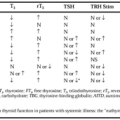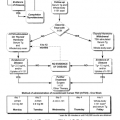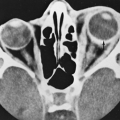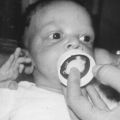PATHOGENESIS OF NONTOXIC GOITER
Part of “CHAPTER 38 – NONTOXIC GOITER“
Nontoxic goiter is the result of an interplay of factors intrinsic and extrinsic to the thyroid. In most patients, subtle limitations on hormonogenesis—imposed, for example, by iodine insufficiency or constitutional biochemical abnormalities in the gland—lead to nontoxic goiter when permissive normal or increased circulating levels of thyroid-stimulating hormone (TSH, thyrotropin) foster gland enlargement. Impaired hormonogenesis, TSH-dependent goiter, and eumetabolism may also reflect the presence of Hashimoto thyroiditis or the ingestion of goitrogens. In the absence of TSH, as in hypopituitarism, nontoxic goiter is rare.
Some have argued that the mechanisms of diffuse and nodular nontoxic goiter are different, with the latter reflecting an autonomous state independent of the permissive effect of TSH.3 Although gland autonomy is present in certain patients with nontoxic nodular goiters, it occurs in few such patients, and whether autonomy develops early or late in the course of goitrogenesis is unknown.4 The suggestion has also been made that the cyclic hypersecretion of TSH in response to periodic underproduction of hormone by the thyroid gland is essential to the development of nodular goiter. Formation of fibrous strands or scar tissue (consequent to cyclic follicular hyperplasia, microscopic hemorrhage, and necrosis) has been postulated to impose the anatomical limits within which nodules form.5 Nevertheless, the possibility seems likely that subtle constitutional derangements of hormonogenesis and the permissive action of circulating TSH act together to produce both diffuse and nodular nontoxic goiter.
Various abnormalities of hormone production have been described in cases of nontoxic goiter (Table 38-1).6,7,8,9,10,11 and 12,12a These biochemical abnormalities, or altered sensitivity to TSH, might be expressed only in certain follicles (biochemical follicular heterogeneity), which would explain the occurrence of nodular
goiter. Excluded from Table 38-1 are genetically determined biochemical lesions that exist in familial goiter with hypothyroidism (see Chap. 47).
goiter. Excluded from Table 38-1 are genetically determined biochemical lesions that exist in familial goiter with hypothyroidism (see Chap. 47).
Stay updated, free articles. Join our Telegram channel

Full access? Get Clinical Tree







